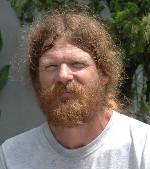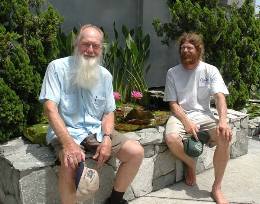|
Escondido, California USA |
 |
|
|
I have been an aquarium hobbyist since I was about 5 years old. My father had an active hobby and was one of the founders of the Los Angeles Aquarium Society. His hatchery in my grandparent's backyard was one of my favorite places to go as a child. It had an odor and a feel that I remember today. During and immediately following World War II, he and his friends used to travel into the deserts of California and Nevada collecting fish from the various hot springs that are to be found there. They collected and spawned many fish that are now extinct, endangered, and/or protected, including Cyprinodon diabolis, C. nevadensis, Empitrichthys merriamii, etc. His stories of their wild times in the desert, swimming in Devil's Hole, running from ranchers, running out of gas during the war, and the fun that they had bringing the fish home and working with them in the labs at USC or at home, were an early inspiration to me and to my older brother, Jack. The first pond that I ever saw was at the home of one of my
father's childhood friends, Dr. William. H. Hildemann, a noted
immunologist at the time. Dr. Hildemann had a small pond in his
yard. I was mesmerized by the lilies and bog plants, particularly
Water Poppy. He later moved to Mandeville Canyon, in the hills
above L.A., where he built a large pond with solar heating. In
it he kept everything from Heterandria formosa (seventh
smallest live-bearing vertebrate in the world) to Pseudotropheus
zebra (a large and aggressive African Cichlid). He also kept
a Victoria each year. His pond was kept so warm that on
cold winter nights you could see steam rising from it. It was
a phenomenal pond and I was always amazed by the verdancy of
the thing. He would throw Poppies, Echinodorus, and Parrot's
Feather away by the garbage can full. I was also inspired by
him to keep aquarium plants, especially Echinodorus and
Cryptocoryne. If he had two of something, one of them
was mine for the asking. He was very inspirational and patient
with a youngster. He died young, but his legacy lives on in some
of the aquariums that my brother and I got from his estate, and
still use. He introduced me to a fellow named Robert Gasser,
of Stuart, Florida, from whom I got some of my first unusual
aquarium plants. Now I had grown up, and my lack of formal education more or less forced me into making my hobby my livelihood. I had been working in a precious metals refinery, making powders for the electronics industry as an R&D Tech, when I was approached by the personnel director about a pond that she had. I worked on it, and then another, and soon it was a regular weekend event. When I was laid off in November 1981, we bought a $7.50 ad in "The Pennysaver", a local throw-away, and I started working on ponds as a vocation. I had never kept any lilies beyond the ones that you can get in an aquarium store. The only ones of any note that I had worked with were Dr. Hildemann's. I had helped him repot some of his (Nymphaea 'Green Smoke', 'Director Moore', 'Albert Greenberg', Victoria), but I was a near-complete neophyte. My learning curve steepened sharply in the early 80's as I struggled to keep my small family alive. I had also never run a business before. One day my wife and I were on the freeway east of San Diego when we saw a sign that said, "Water Lilies". We pulled off of the road and found the place. It was the home of the Drakes, and the place was called Live Oak Water Gardens. Mr. and Mrs. Drake were very old and infirm, and, sadly, they had allowed their tanks to dry up over the summer. There were still some Iris fulva alive under a tree and we got them. They had allowed about a hundred genuine N. 'Virginalis' to dry up in one tank. I wish that I had found them that spring instead of that summer. |
||
| At any rate, they told me that if I wanted to keep lilies that I had to meet this fellow in Del Cerro named Walter Pagels. They gave me his phone number and I uncharacteristically called him almost immediately. That evening, I think. He said that he would be glad to meet me and show me around, so we set up a meeting for a few days later, probably on a weekend because he was still working then. Well, my life has never been the same since. Here was my next inspiration. His enthusiasm, generosity, and sheer thoroughness of knowledge made me realize at once how little I knew and how much I wanted to know more. |
 Walter Pagels & David |
|
|
Things went from there. We survived Reaganomics, built the
business in spite of ourselves, too stubborn, or stupid, to give
up when we should have, and continued to build on to what we
had on our little lot on a west facing cliff in southeast San
Diego. Between pond jobs I painted houses, repaired roofs, fixed
friends' cars, including Pagels' once, and did any other thing,
mostly legal, that would turn a buck. Eventually, we developed
a reputation as people who knew whereof we spoke when the conversation
was about ponds, and eventually work started to find us. I spoke
to garden clubs, and generally espoused the virtues of water
gardening to any body who would listen to me. We moved back to our yard in San Diego and started over. Pretty soon our yard was bursting with plants and we needed an outlet, which presented itself in the form of one of the premier nurseries in San Diego County. They were desperately in need of a new water plant section, and we happily provided it for them. We built tanks, brought in plants, and have been selling them there ever since. Realizing, once again, that we could not depend upon the local
market for our livelihood, we decided to establish a web-site
for our business. This was in 1995, when the internet was just
getting started. Being on the internet would avoid the incredible
expense, and ecological disaster, of printing a glossy catalog,
and would expose us to people all over the country at all times
of the year, day or night. Things developed slowly at first,
but soon it began to actually pay for itself. After a couple
of years it began to turn a profit. Now, the internet business
is easily a third of our income and it continues to grow. I travel when I can, thrice with Walter Pagels now, twice
to Florida, and in April 2003, to Australia for almost three
weeks. I always learn more than I can remember when I travel
with him, and I always look forward to the next opportunity.
I definitely plan to go back to Australia to continue what we
started there in '03, and I am currently (12-06) looking forward
to a trip to South America with Don Bryne, of Suwannee Labs,
to look for Victorias in northern Brazil. This is the
realization of a 40 year-old dream of mine, and when the opportunity
presented itself this past summer, I got wobbly in the knees
and swore to find a way to go. Since I first began to read books
on plants and fish, I have wanted to go to the Amazon to look
for myself. |
||
by David Curtright
Nymphoides and Villarsia
By David Curtright